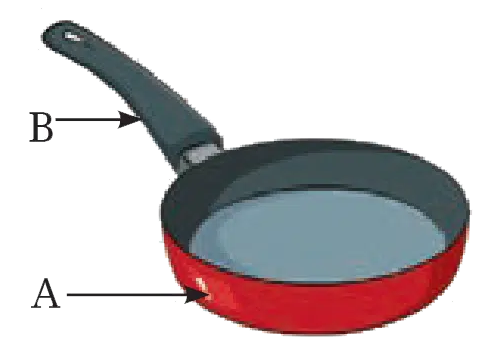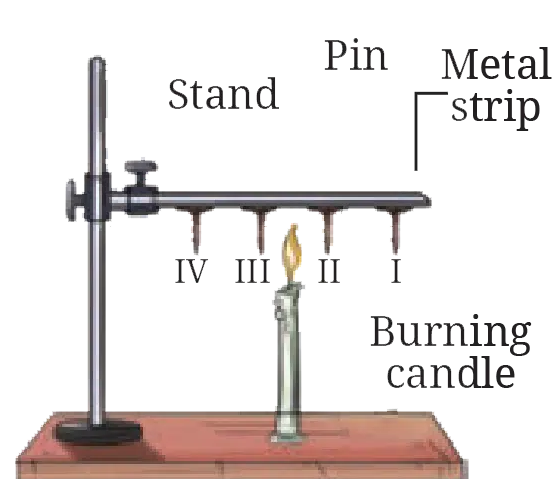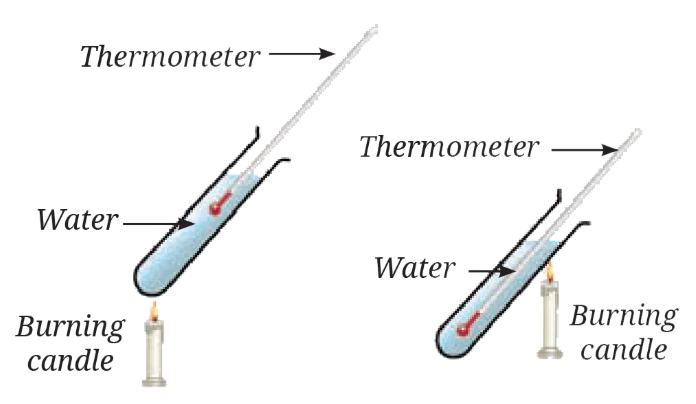Solutions For All Chapters – Science Curiosity Class 7
Heat Transfer in Nature
1. Choose the correct option in each case.
(i) Your father bought a saucepan made of two diff erent materials, A and B, as shown in Fig. 7.14. The materials A and B have the following properties —
(a) Both A and B are good conductors of heat
(b) Both A and B are poor conductors of heat
(c) A is a good conductor and B is a poor conductor of heat
(d) A is a poor conductor and B is a good conductor of heat
Answer: (c) A is a good conductor and B is a poor conductor of heat.
(ii) Pins are stuck to a metal strip with wax and a burning candle is kept below the rod, as shown in Fig. 7.15. Which of the following will happen?
(a) All the pins will fall almost at the same time
(b) Pins I and II will fall earlier than pins III and IV
(c) Pins I and II will fall later than pins III and IV
(d) Pins II and III will fall almost at the same time
Answer: (d) Pins II and III will fall almost at the same time.
(iii) A smoke detector is a device that detects smoke and sounds an alarm. Suppose you are fitting a smoke detector in your room. The most suitable place for this device will be:
(a) Near the floor
(b) In the middle of a wall
(c) On the ceiling
(d) Anywhere in the room
Answer: (c) On the ceiling.
2. A shopkeeper serves you cold lassi in a tumbler. By chance, the tumbler had a small leak. You were given another tumbler by the shopkeeper to put the leaky tumbler in it. Will this arrangement help to keep the lassi cold for a longer time? Explain.
Answer: Yes, this arrangement can help keep the lassi cold for a longer time. The air trapped between the two tumblers acts as an insulator, reducing the flow of heat from the surroundings to the lassi. This slows down warming and helps keep it cold.
3. State with reason(s) whether the following statements are True [T] or False [F].
(i) Heat transfer takes place in solids through convection.
Answer: False
(ii) Heat transfer through convection takes place by the actual movement of particles.
Answer: True
(iii) Areas with clay materials allow more seepage of water than those with sandy materials.
Answer: False
(iv) The movement of cooler air from land to sea is called land breeze.
Answer: True
4. Some ice cubes placed in a dish melt into water after some time. Where do the ice cubes get heat for this transformation?
Answer: The ice cubes absorb heat from their surroundings, including the air and the surface they are placed on. This heat causes the ice to melt, changing it from a solid state to a liquid state, turning it into water.
5. A burning incense stick is fixed, pointing downwards. In which direction would the smoke from the incense stick move? Show the movement of smoke with a diagram.
Answer: The smoke from the incense stick will move in the upward direction because smoke is a mixture of hot gases and tiny solid particles. Since hot air rises due to convection, the smoke moves upwards.
6.Two test tubes with water are heated by a candle flame as shown in Fig. 7.16. Which thermometers (Fig. 7.16a or Fig. 7.16b) will record a higher temperature? Explain.
Answer:
In Fig. (a), the thermometer is placed at the top of the test tube and candle flame heats the bottom of the test tube directly. The water at the bottom gets heated first. As the water heats up, it rises due to convection, carrying heat to the top, where the thermometer is placed. So, the thermometer quickly records a temperature rise.
In Fig. (b), the thermometer is placed at the bottom of the test tube, but the candle flame heats the side of the test tube. The side heating may not be as effective in transferring heat to the bottom where the thermometer is placed. Therefore, the thermometer in Fig. (a) will record a higher temperature.
7. Why are hollow bricks used to construct the outer walls of houses in hot regions?
Answer: The air gets trapped in the hollow bricks and air is a poor conductor of heat. This trapped air acts as an insulator and prevent the heat from entering the house, keeping the interior cooler.
8. Explain how large water bodies prevent extreme temperature in areas around them.
Answer: Large water bodies like seas and oceans prevent extreme conditions in areas around them. In coastal areas during day, the land heats up faster than water, so cooler air from the sea flows towards the land (sea breeze), keeping the temperature moderate. At night, land cools down faster than water. The air above the sea remains warmer, while the cooler air from the land moves towards the sea (land breeze). This movement of air helps prevent extreme temperatures in coastal regions.
9. Explain how water seeps through the surface of the Earth and gets stored as groundwater.
Answer: Water seeps through the surface of the Earth by gradually passing through the soil and porous rocks. This process is known as infiltration. This water fills the pores and cracks in rocks and soil and gets stored underground as groundwater. The layers of sediments and rocks that store water in their pore spaces are known as aquifers.
10.The water cycle helps in the redistribution and replenishment of water on the Earth. Justify the statement.
Answer: The water cycle helps in the continuous redistribution and replenishment of water on Earth through the movement of water in different stages, such as evaporation, condensation and precipitation. Water from oceans, rivers and lakes evaporates due to the Sun’s heat, forms clouds through condensation, and falls back to Earth as rain or snow through a process called precipitation. The rain refills lakes, rivers and groundwater, ensuring the continuous availability of water on Earth.





Leave a Reply